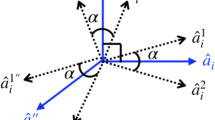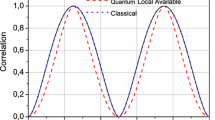Abstract
In this paper, we study the Hardy nonlocality argument (HNA) and the Cabello nonlocality argument (CNA) under the Information Causality (IC), Macroscopic Locality (ML) and Local Orthogonality (LO) principles with respected to Local Randomness. We show that, in the context of all possibilities of local randomness, the gap between the quantum mechanics and the above principles, in the CNA is larger than the HNA. Therefore, the CNA is stronger control than the HNA for detecting post-quantum nosignalling correlations in the bipartite systems.
Similar content being viewed by others
References
Tsirelson, B.S.: Quantum generalizations of Bell's inequality. Lett. Math. Phys. 4, 93–100 (1980)
Bell, J.S.: On the Einstein Podolsky Rosen paradox. Physics. 1, 195–200 (1964)
Clauser, J.F., Horne, M.A., Shimony, A., Holt, R.A.: Proposed Experiment to Test Local Hidden-Variable Theories. Phys. Rev. Lett. 23, 880–884 (1969)
Popescu, S., Rohrlich, D.: Quantum nonlocality as an axiom. Found. Phys. 24, 379–385 (1994)
Hardy, L.: Quantum mechanics, local realistic theories, and Lorentz-invariant realistic theories. Phys. Rev. Lett. 68, 2981–2984 (1992)
Hardy, L.: Nonlocality for two particles without inequalities for almost all entangled states. Phys. Rev. Lett. 71, 1665–1668 (1993)
Mermin, N.D.: Quantum mysteries refined. Am. J. Phys. 62, 880–887 (1994)
Cabello, A.: Phys.Rev. A. 65, 032108 (2002)
Liang, L.-m., Li, C.-z.: Phys. Lett. A. 335, 371–373 (2005)
Choudhary, S.K., Ghosh, S., Kar, G., Kunkri, S., Rahaman, R., Roy, A.: Quantum Information and Computation. 10(9 & 10), 0859–0871 (2010)
Kar, G.: Hardy's nonlocality for mixed states. Phys. Lett. A. 228, 119–120 (1997)
Rabelo, R., Law, Y.Z., Scarani, V.: Device-Independent Bounds for Hardy’s Experiment. Phys. Rev. Lett. 109, 180401 (2012)
Kunkri, S., Choudhary, S.K., Ahanj, A., Joag, P.: Nonlocality without inequality for almost all two-qubit entangled states based on Cabello’s nonlocality argument. Phys. Rev. A. 73, 022346 (2006)
van Dam, W.: Ph.D. thesis. In: University of Oxford (2000)
Brassard, G., Buhrman, H., Linden, N., Methot, A.A., Tapp, A., Unger, F.: Limit on Nonlocality in Any World in Which Communication Complexity Is Not Trivial. Phys. Rev. Lett. 96, 250401 (2006)
Pawlowski, M., Paterek, T., Kaszlikowski, D., Scarani, V., Winter, A., Zukowski, M.: Information causality as a physical principle. Nature. 461, 1101–1104 (2009)
Navascués, M., Wunderlich, H.: Proc. Roy. Soc. Lond. A. 466, 881–890 (2009)
Fritz, T., Sainz, A.B., Augusiak, R., Brask, J.B., Chaves, R., Leverrier, A., Acin, A.: Nat. Commun. 4(2263), (2013)
Cabello, A.: Exclusivity principle and the quantum bound of the Bell inequality. Phys. Rev. A. 90, 062125 (2014)
Oppenheim, J., Wehner, S.: The Uncertainty Principle Determines the Nonlocality of Quantum Mechanics. Science. 330, 1072–1074 (2010)
Banik, M., Gazi, M.R., Ghosh, S., Kar, G.: Phys. Rev. A. 87, 052125 (2013)
D. Rohrlich, “PR-box correlations have no classical limit, in Quantum Theory", A Two Time Success Story, Yakir Aharonov Festschrift; D.C. Struppa, J.M. Tollaksen, Eds.; Springer: Milan, Italy, 2013; pp. 205–211
D. Rohrlich,arXiv: 1407.8530
D. Rohrlich,arXiv: 1408.3125
Gisin, N.: Quantum correlations in Newtonian space and time: faster than light communication or nonlocality. In: (the Frontiers Collection) Quantum [Un]Speakables, vol. II, pp. 321–330. Half a Century of Bell’s Theorem; R. Bertlmann, A. Zeilinger, Eds.; Springer, Berlin, Germany (2017)
Ahanj, A., Kunkri, S., Rai, A., Rahaman, R., Joag, P.S.: Bound on Hardy’s nonlocality from the principle of information causality. Phys. Rev. A. 81, 032103 (2010)
Das, S., Banik, M., Gazi, M.R., Rai, A., Kunkri, S.: Phys. Rev. A. 88, 062101 (2013)
Gallego, R., Wurflinger, L.E., Acin, A., Navascues, M.: Quantum Correlations Require Multipartite Information Principles. Phys. Rev. Lett. 107, 210403 (2011)
Das, S., Banik, M., Rai, A., Gazi, M.D.R., Kunkri, S.: Hardy's nonlocality argument as a witness for postquantum correlations. Phys. Rev. A. 87, 012112 (2013)
Gazi, M.D.R., Rai, A., Kunkri, S., Rahaman, R.: Local randomness in Hardy's correlations: implications from the information causality principle. J. Phys. A Math. Theor. 43, 452001 (2010)
Zoka, G., Ahanj, A.: Local randomness in Cabello’s non-locality argument from the information causality principle. Quantum Stud.: Math. Found. 3(2), 135–145 (2016)
Barrett, J., Linden, N., Massar, S., Pironio, S., Popescu, S., Roberts, D.: Nonlocal correlations as an information-theoretic resource. Phys. Rev. A. 71, 022101 (2005)
Allcock, J., Brunner, N., Pawlowski, M., Scarani, V.: Phys. Rev. A. 80(R), 040103 (2009)
W. van Dam, e-print arXiv:quant-ph/0501159
S. Wolf and J. Wullschleger, e-print arXiv:quant-ph/0502030v1 (2005)
Allcock, J., Brunner, N., Pawlowski, M., Scarani, V.: Phys. Rev. A. 80(R), 040103 (2009)
Navascues, M., Pironio, S., Acin, A.: Bounding the Set of Quantum Correlations. Phys. Rev. Lett. 98, 010401 (2007)
Navascues, M., Pironio, S., Acin, A.: A convergent hierarchy of semidefinite programs characterizing the set of quantum correlations. New J. Phys. 10, 073013 (2008)
Cereceda, J.L.: Found. Phys. Lett. 13, 427–442 (2000)
Author information
Authors and Affiliations
Corresponding author
Additional information
Publisher’s Note
Springer Nature remains neutral with regard to jurisdictional claims in published maps and institutional affiliations.
Appendices
Appendix 1
The 16 Local matrices for bipartite system with binary input-output:
The 8 Non-Local matrices for bipartite system with binary input-output:
Appendix 2
The following inequalities are sufficient for obtaining the upper bound of the HNA under LO principle [27]. The inequalities can be shown, in terms of variables ek, mi and ni (k ∈ {1, 2, 3, 4} and i ∈ {1, 2}).
The relation between the 8 independent parameter and the coefficients ci is obtained by comparing the matrix (5) and the Hardy correlation matrix (15). So, we have:
Appendix 3
The following inequalities are sufficient for obtaining the upper bound of CNA under LO principle [27]. The inequalities can be represented, in terms of variables ek, mi and ni (k ∈ {1, 2, 3, 4} and i ∈ {1, 2}):
The relation between 8 independent parameters and coefficients ci is obtained by comparing the matrix (5) and the Cabelo correlation matrix(18). So, we have:
Rights and permissions
About this article
Cite this article
Ahanj, A. The Cabello Nonlocality Argument is Stronger Control than the Hardy Nonlocality Argument for Detecting Post-Quantum Correlations in the Bipartite Systems. Int J Theor Phys 58, 1441–1455 (2019). https://doi.org/10.1007/s10773-019-04032-8
Received:
Accepted:
Published:
Issue Date:
DOI: https://doi.org/10.1007/s10773-019-04032-8




